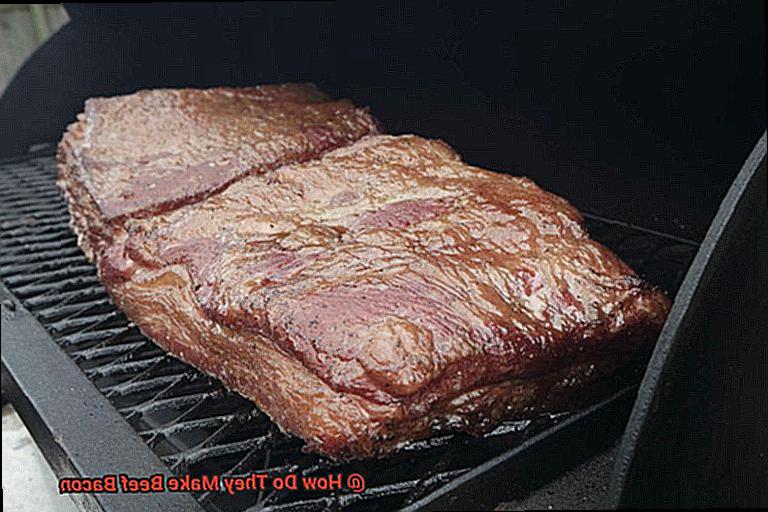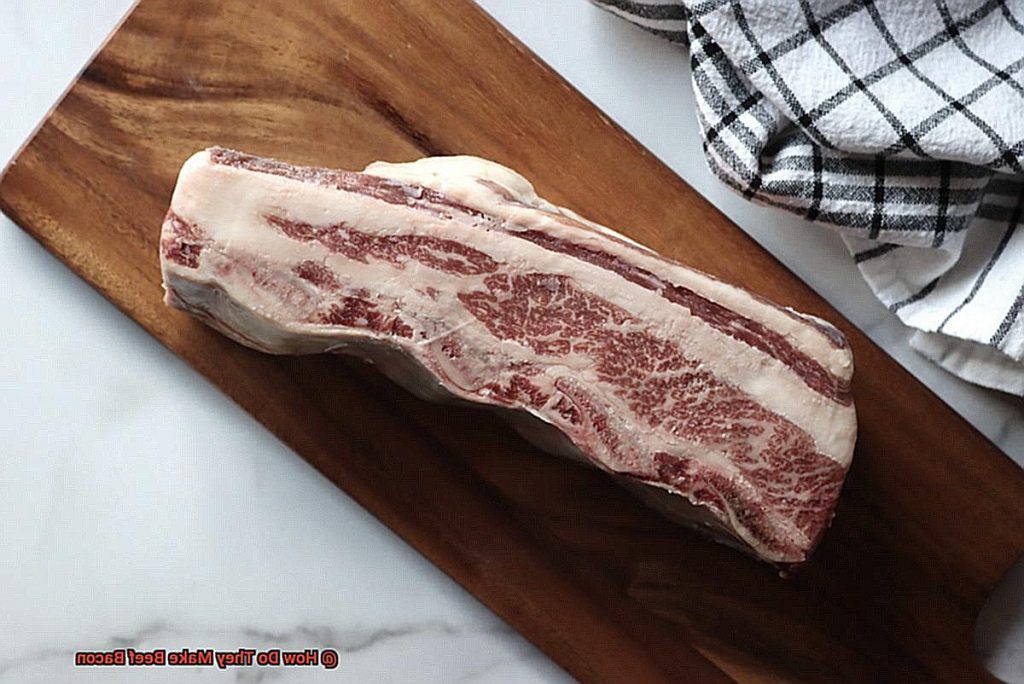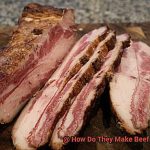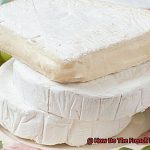Who doesn’t love the smell of sizzling bacon in the morning? It’s crispy, salty, and smoky flavors are enough to make anyone’s mouth water. But what if you don’t eat pork? Fear not, because beef bacon is here to save the day.
But wait, how do they make beef bacon? It’s not exactly a cut of meat that you see every day at your local butcher shop. Lucky for you, we’re about to take a deep dive into the fascinating process of beef bacon-making.
First things first – just like pork bacon, beef bacon comes from the belly of a cow. To start the process, a fresh and high-quality cut of beef belly is selected and then rubbed with an array of seasonings and spices including salt, sugar, and pepper. After this step, it’s hung up to dry for several days so that the flavors can develop and penetrate the meat.
But it doesn’t stop there. The real magic happens when the beef belly is smoked using different types of wood such as hickory or apple. This is where that delicious smoky aroma and flavor we all know and love come from. Once it’s been smoked to perfection, it’s sliced up just like pork bacon and ready to be cooked.
And let me tell you – it tastes just as good as its pork counterpart. So whether you’re avoiding pork for religious reasons or simply prefer the taste of beef over pork, give beef bacon a try. Stay tuned as we explore some tasty toppings and dishes that go perfectly with this delicious alternative.
Contents
Preparing the Meat for Curing
Preparing the meat for curing is a crucial step in creating the perfect beef bacon. Careful consideration must be given to selecting the right cut of meat – belly or brisket are ideal due to their high-fat content, which is essential for producing tender and flavorful beef bacon.
Once you’ve selected your meat, it’s time to prepare it for seasoning. The trimming process is crucial, as it ensures that the beef bacon will have a uniform thickness and texture. Excess fat and connective tissue must be removed before rubbing the meat with a mixture of salt, sugar, and spices. This mixture serves to both flavor the meat and draw out any excess moisture.
After seasoning, the meat is placed into a container or vacuum-sealed bag and left to cure for several days. The salt and sugar mixture works to preserve the meat and give it a distinct flavor. The length of time that the meat is cured can vary depending on factors such as the size of the cut and the desired level of flavor.
Once the curing process is complete, it’s time to rinse off any excess salt or seasoning and begin smoking. Low heat over several hours using popular woods such as hickory, applewood, or mesquite will give your beef bacon its unique flavor.
Finally, it’s time to enjoy your delicious beef bacon. It can be served alongside any breakfast dishes or used as a substitute for pork bacon in recipes. The rich, meaty flavor of beef bacon is sure to impress anyone looking for a tasty alternative.
Applying the Curing Mixture
Beef bacon is a delicious alternative that requires one crucial step – applying the curing mixture.
The curing mixture is a combination of salt, sugar, and spices that preserve and add flavor to the meat. To ensure even absorption, it’s essential to prepare the beef belly by trimming off excess fat and bones.
Now it’s time to apply the curing mixture. Rub it all over the surface of the beef belly, using your hands or a brush. But be sure to wear gloves to avoid salt irritation. Every inch of meat must be covered for maximum flavor.
Once applied, let the beef belly rest in a cool place for several days. This allows the flavors to penetrate and cure the meat thoroughly. The duration of curing depends on personal preference and the size of the beef belly.
When fully cured, it’s time to cook the beef bacon. You can smoke it for extra flavor or fry it in a pan or oven. But remember to slice it thinly against the grain for optimal tenderness and taste.
Curing the Meat in the Refrigerator
If so, then you know that curing the meat is an essential step in the process. But what exactly is curing, and how can you do it safely and effectively in your own refrigerator?
Curing is a process that involves adding a mixture of salt, sugar, and spices to meat to preserve it and enhance its flavor. To make beef bacon, you will need to create a specific recipe of these ingredients and coat the meat thoroughly with the mixture.
Once the meat is coated, it’s time to let it work its magic in the refrigerator. This can take anywhere from 5-7 days, depending on the thickness of the beef. During this time, the curing mixture will penetrate the meat, infusing it with flavor and preserving it for later use.
But be warned: curing meat at home can be dangerous if not done correctly. That’s why it’s crucial to follow a trusted recipe and practice proper food safety measures. Make sure to coat all sides of the meat evenly with the curing mixture, and use a plastic bag or container to keep it sealed and safe in the fridge.
When the curing process is complete, it’s important to rinse off any excess curing mixture from the meat and pat it dry. This will help prevent the bacon from becoming too salty or overpowering during smoking or cooking.
Rinsing and Drying the Meat

Then let’s talk about the importance of rinsing and drying the meat before smoking. This step may seem like a no-brainer, but trust us – it makes all the difference in the final product.
First things first, select a high-quality cut of beef like brisket or flank steak and remove any excess fat or gristle. Then, give it a thorough rinse under cool running water to remove any surface bacteria or contaminants. Think of it as giving your meat a refreshing shower before its big debut.
Now that your meat is squeaky clean, it’s time to dry it off. Pat it down with paper towels until it’s completely dry, paying extra attention to any crevices or folds. This step is crucial to prevent the meat from sticking to the smoker racks and ensure even smoking.
But we’re not done yet – it’s time to add some flavor. Whether you prefer a simple salt and pepper seasoning or a complex marinade, make sure to apply it evenly. Let the meat marinate for at least 30 minutes before smoking to allow the flavors to penetrate.
Smoking the Beef Bacon
Look no further than the world of beef bacon smoking. This crucial step in the process of making beef bacon adds flavor and helps preserve the meat. Don’t be intimidated by the smoking process, as it’s simpler than you might think. With proper preparation, monitoring, and some tips and tricks, you can achieve delicious results that will leave your taste buds begging for more.
Preparing Your Smoker
The first step in smoking beef bacon is to prepare your smoker. Whether you choose a wood-fired, electric or gas smoker, ensure that it’s clean and ready to use. Any leftover debris or ash from prior smoking sessions can affect the flavor of your beef bacon.
Pro Tip: Soak your wood chips or pellets in water for at least 30 minutes before adding them to the smoker. This will help them last longer and produce more smoke.
Smoking Your Beef Bacon
Once your smoker is prepared, it’s time to add the beef bacon. Before placing it on the racks, dry it off with paper towels to prevent sticking. Apply your favorite seasoning or marinade evenly to add flavor and let it marinate for at least 30 minutes.
When smoking beef bacon, it’s essential to monitor the temperature of your smoker to keep it within a safe range. The ideal temperature should be between 200-250 degrees Fahrenheit. If it’s too hot, you risk overcooking the meat, while too low will result in uneven cooking.
Pro Tip: Avoid opening your smoker too often during the smoking process to prevent heat loss and prolong cooking time.
Periodically check on and rotate your beef bacon to ensure even smoking. Depending on thickness, smoking can take anywhere from two to four hours. Once smoked to perfection, remove from the smoker and let it cool for a few minutes before slicing.
Savoring Your Beef Bacon
Your smoked beef bacon is ready to be enjoyed. Its smoky flavor and tender texture make it a versatile ingredient in many dishes like breakfast plates, sandwiches, and salads. Store it in an airtight container in the refrigerator for up to a week or freeze it for later use.
Choosing Wood for Smoking
Smoking beef bacon is an art that requires the perfect balance of seasoning, meat, and most importantly, wood. The right wood can make all the difference in achieving the desired flavor and aroma. Let’s explore the different types of wood that can be used for smoking beef bacon and how they can enhance or overpower the taste of the meat.
Hickory is a popular choice among pitmasters for its strong, smoky flavor that pairs perfectly with beef. Its slow-burning nature makes it ideal for long smoking sessions, allowing the hickory to infuse into every inch of the meat. If you want to achieve that classic, bold smoky taste, hickory is the way to go.
Oak is another versatile wood that can be used for both hot and cold smoking. It has a milder flavor than hickory but still adds a rich, smoky taste to the meat. Oak also comes in different varieties, such as red and white oak, each with its unique flavor profile. Whether you’re looking for a subtle or robust smoke flavor, oak has got you covered.
If you’re after a bolder taste, mesquite is an excellent choice. But be careful not to use too much as its intense flavor can quickly overpower other flavors in the meat. Mesquite is best used in combination with other woods like hickory or oak to balance out its strong taste.
Fruitwoods such as apple, cherry, and peach are perfect choices for those who prefer a sweeter, more delicate smoke flavor. Their light smoke adds a subtle fruitiness to the meat without overwhelming it. These woods are also great for smoking poultry or fish.
It’s important to remember that the size and shape of the wood also affect the smoking process. Smaller chips or chunks of wood burn more quickly and produce a stronger smoke flavor, while larger logs burn more slowly and produce a milder smoke. So depending on your desired taste, choose the size and shape of the wood accordingly.
Enjoying Beef Bacon
If you’re looking for a new and exciting way to enjoy bacon, look no further than beef bacon. This delicious alternative to traditional pork bacon has been gaining popularity in recent years, and it’s not hard to see why.
First off, beef bacon is a healthier option for those looking to cut back on their pork intake. It’s leaner than traditional bacon, meaning it has fewer calories and less fat. Plus, it contains more protein, making it a great choice for those watching their diet.
But the real star of the show is the flavor. Beef bacon has a unique and distinct taste that sets it apart from its pork counterpart. The smoking process gives it a rich, smoky flavor that pairs perfectly with eggs, burgers, sandwiches, and more. And the blend of spices used to season the beef belly adds an extra layer of deliciousness.
When it comes to cooking beef bacon, the possibilities are endless. Fry it up in a pan for breakfast or add it to your favorite burger recipe for a tasty twist. You can even use it as a topping for pizza or sprinkle it on top of macaroni and cheese.
The process of making beef bacon is similar to that of pork bacon, but with a few key differences. Instead of curing the belly with salt and sugar, beef bacon is seasoned with a blend of spices before being smoked over hickory or apple wood chips. The amount of time it’s smoked can vary depending on the desired flavor profile.
Substituting Pork Bacon with Beef Bacon
To start with, beef bacon is made from the same cuts of meat as traditional pork bacon. However, the process used to make it differs slightly. The beef is cured with a mixture of salt, sugar, and spices before being smoked over wood chips or in a smokehouse. This gives it that irresistible smoky flavor that makes it a perfect addition to a variety of dishes.
One of the main advantages of beef bacon over pork bacon is its lower fat and calorie content. This makes it an ideal choice for those who are watching their weight or cholesterol intake. But don’t worry, just because it’s leaner doesn’t mean it lacks flavor. In fact, many people find that beef bacon has a more robust taste than its pork counterpart.
When substituting pork bacon with beef bacon in recipes, there are a few things to consider. The cooking times and temperatures may need to be adjusted due to the differences in fat content and thickness between the two types of bacon. It’s also important to weigh up the flavor profile of the dish and whether beef bacon would complement or overpower other ingredients.
In summary, substituting pork bacon with beef bacon is an excellent option for those who can’t or don’t want to eat pork products. With its unique flavor and health benefits, beef bacon is a delicious addition to any meal. So why not try something new and give it a shot? Your taste buds (and your waistline) will thank you.
To make it easier for you to decide whether to substitute pork bacon with beef bacon, here are some more reasons why you should consider making the switch:
- Beef bacon contains less saturated fat than pork bacon, making it a healthier option
- Beef bacon is a great source of protein, which is essential for building and repairing muscles
- The rich and savory flavor of beef bacon is perfect for adding depth to a variety of dishes, from burgers to salads to breakfast omelets
- Beef bacon is a versatile ingredient that can be used in place of pork bacon in many recipes, including soups, stews, and casseroles.
Conclusion
In summary, beef bacon is a delectable and increasingly popular option for those seeking an alternative to traditional pork bacon. The process of crafting this savory treat involves carefully selecting high-quality cuts of beef belly or brisket and applying a blend of salt, sugar, and spices before smoking it over wood chips like hickory or apple.
The curing process is the key to achieving the perfect flavor and texture in beef bacon. This requires meticulous attention to detail when choosing the right cut of meat, trimming any excess fat or connective tissue, and applying the curing mixture evenly. After seasoning, the meat must be left to cure for several days so that its flavors can fully develop and permeate throughout.
Once smoked to perfection, beef bacon can be enjoyed as a flavorful addition to any breakfast dish or used as a substitute for pork bacon in various recipes. Its rich, meaty taste is guaranteed to impress anyone looking for something new.
When using beef bacon in place of pork bacon in recipes, it’s important to consider cooking times and temperatures as well as how its distinct flavor profile will complement other ingredients.
Ultimately, whether you’re avoiding pork for religious reasons or simply prefer the taste of beef over pork, give beef bacon a chance. It’s leaner than traditional pork bacon but doesn’t compromise on taste or versatility.






